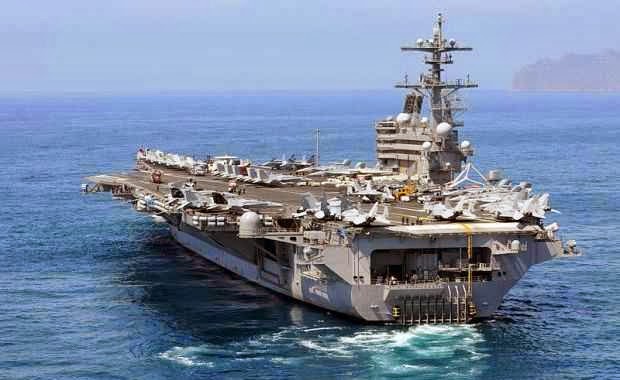Tasked with a multi-mission attack / ASW role, the first of class, USS Nimitz, was commissioned in 1975. The last of the class, USS George HW Bush (CVN 77), was commissioned in January 2009.
"The Nimitz carrier reaches a maximum speed of over 30kt."
USS Ronald Reagan (CVN 76) made its first operational deployment between January and May 2006, in support of Operation Iraqi Freedom and Enduring Freedom in the Arabian Gulf.
In September 2008, USS George Washington (CVN 73) arrived at its new home port of Yokosuka, Japan, replaced USS Kitty Hawk, which was decommissioned in May 2009, as the flagship of the US 7th fleet.
The keel for the tenth and last Nimitz Class, USS George HW Bush (CVN 77), was laid in September 2003. The carrier was christened in October 2006 and entered service in 2009. The vessel has a modernised island house with new radar tower and transparent armour windows as well as upgraded navigation and communications systems. It has a new aircraft launch and recovery system and JP-5 fuel system for improved storage and handling of aircraft fuel.
This is the first transition ship to a new class of carriers, Gerald R Ford (CVN78) ,(also known as CVN 21 and CVNX), planned for commission in 2015. Northrop Grumman Newport News is the prime contractor for the programme and Raytheon is responsible for weapons system integration. CVN 78 will incorporate new technologies including a new multi-function radar system, volume search radar and open architecture information network, providing a significantly reduced crew requirement and a new nuclear power plant.
Nimitz class aircraft carrier design
The more recent Nimitz Class carriers (CVN72-CVN76) have a displacement of 102,000t when fully loaded. They have a length of 317m and beam of 40.8m.The carrier reaches a maximum speed of over 30kt, and accommodates a complement of 3,184 personnel (with 203 officers); 2,800 aircrew (with 366 officers); and 70 flag (with 25 officers)
Aircraft
The 50 TACAIR air wing includes up to 82 aircraft. Typically this would be: 12 F/A-18E/F Hornets, 36 F/A-18 Hornets, four E-2C Hawkeyes, and four EA-6B Prowlers fixed-wing; and the following helicopters: four SH-60F and two HH-60H Seahawks. The carrier can also deploy S-3B Viking aircraft, but these are being phased out and replaced with the F/A-18E/F Super Hornet. The S-3B Viking was finally decommissioned in January 2009.
The last operational deployment of the F-14, deployed on US carriers since 1972, was in March 2006. The F-14 was decommissioned in September 2006.
Air wings can be varied according to the nature of the operation: for example, in 1994, 50 army helicopters replaced the usual air wing on the USS Dwight D Eisenhower during operations off Haiti.
The flight deck measures 333m x 77m and is equipped with four lifts, four steam-driven catapults and four arrester wires. The carrier is capable of launching one aircraft every 20 seconds.
In April 2005, the US Naval air systems command (NAVAIR) selected General Atomics Electromagnetic Systems for the system development and demonstration (SDD) phase of the advanced arresting gear (AAG) programme, to provide a new arrestor system for USN carriers.
Missiles
The more recently built carriers are armed with three Raytheon GMLS mk29 eight-cell launchers for Nato Sea Sparrow surface-to-air missiles. Sea Sparrow has a range of 14.5km and semi-active radar terminal guidance.
The carriers are also fitted with the Raytheon RAM (rolling airframe missile) system, which provides short-range defence against incoming anti-ship missiles including sea-skimming missiles.
USS Stennis was fitted with RAM in 2005 and began firing trials of the system in June 2006. One Sea Sparrow mount and one Phalanx CIWS mount were removed to fit the RAM.
USS John C Stennis was the first carrier to fire the evolved Sea Sparrow missile (ESSM) in October 2008.
Guns
There are four Raytheon / General Dynamics 20mm Phalanx six-barrelled Mk 15 close-in weapon systems which have a firing rate of 3,000 rounds/min and a range of 1.5km.
Countermeasures
Decoys include four Sippican SRBOC (super rapid bloom off-board chaff) six-barrelled mk36 decoy launchers, which deploy infrared flares and chaff, SSTDS torpedo defence system and AN/SLQ-25 Nixie torpedo countermeasures system, from Argon ST of Fairfax, Virginia.
The Raytheon AN/SLQ-32(V) electronic warfare system detects hostile radar emissions by two sets of antennae and the system analyses the pulse repetition rate, the scan mode, the scan period, and the frequency. The system identifies the threat and direction, provides a warning signal and interfaces to the ship's countermeasures systems.
Combat systems
The carriers' combat data systems are based around the block 0 or 1 naval tactical and advanced combat direction system (ACDS) with communications links 4A, 11, 14, and 16. Weapons control is managed by three mk91 mod 1 MFCS directors for the Sea Sparrow missile.
USS Nimitz, USS Ronald Reagan and USS John Stennis have been fitted with the SSDS mk2 mod 0 ship self-defence system, developed by Raytheon. The SSDS will provide automated self-defence against anti-ship cruise missiles (ASCMs) by integrating and coordinating the ship's weapon and electronic warfare systems.
Sensors
Air search radars include the ITT SPS-48E 3-D, operating at E/F-band; Raytheon SPS49(V)5, C/D-band; and Raytheon mk23 TAS, D-band. Surface search radar is the Northrop Grumman Norden Systems SPS-67V, operating at G-band.Propulsion
The nuclear-powered carrier has two General Electric pressurised water reactors driving four turbines of 260,000hp (194MW) and four shafts. There are four emergency diesels of 10,720hp (8MW).




No comments:
Post a Comment